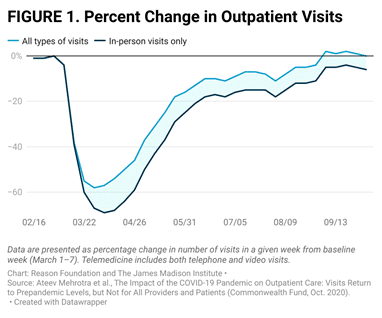Throughout the COVID-19 pandemic, telehealth has provided patients safe access to health care services as they navigated stay-at-home orders, social distancing measures, and extraordinary demands placed on patients and the health care workforce. Telehealth enables patients to communicate with health care providers remotely via telecommunications and digital communications technologies.
In early 2020, total outpatient visits declined dramatically nationwide, but the increased use of telehealth made up for some of the gaps in care. The shaded area in Figure 1 below reflects this increased use of telehealth. In Florida, total weekly visits declined by 24 percent last year between May 20 and June 16. Over that same period, telehealth visits accounted for 17.4 percent of total visits in the state.
A patchwork of state and federal regulations normally governs interactions between health care workers serving their patients via telehealth. But emergency actions by the federal government, as well as temporary changes to various state laws, have temporarily eliminated or reduced regulatory barriers to the use of telehealth across the country during the pandemic. Prior to these actions, varying definitions of telehealth, onerous licensing restrictions, and other outdated regulations limited telehealth adoption by patients and care providers.
Fortunately for Floridians, lawmakers in the Sunshine State recognized the potential tradeoffs associated with health care regulation before the coronavirus pandemic began. In 2019, the Florida legislature enacted a significant improvement to Florida’s telehealth policies. The reforms created a unified definition of telehealth, altered rules around insurance coverage of telehealth services, and authorized a wide range of health care professionals to engage in telehealth services.
The 2019 reforms also required licensing boards to create a telehealth registration process for out-of-state providers. The registration process allows providers licensed in other states to practice telehealth in Florida without obtaining an additional Florida license. Allowing out-of-state providers to practice telehealth in Florida will help offset the growing demand for health care services as Florida’s population continues to grow and age.
Yet, as Sal Nuzzo and I explain in a new report published by Reason Foundation and the James Madison Institute, there are many ways to improve Florida’s telehealth laws.
Registered out-of-state telehealth providers are required to work within their scope of practice (SOP) as provided by Florida law––even if they are licensed in a less restrictive state. Scope of practice refers to the range of services that a health care professional may provide. This creates an unnecessary burden for out-of-state providers who must maintain knowledge of SOP provisions in their state and in Florida. Short of expanding SOP requirements in Florida, allowing these providers to practice within the SOP provisions of their state of residence would reduce this burden and expand access to care.
There are many technologies through which patients can access telehealth. Decisions regarding how telehealth services are delivered are best left to the discretion of patients and their providers. Therefore, definitions of telehealth should be broad and allow for future innovation.
For example, Florida’s definition of telehealth explicitly excludes audio-only phone calls, emails, and facsimile (fax) transmissions. Including these and other common forms of remote communication would provide greater flexibility to patients and care providers.
While telehealth services are covered for most Florida Medicaid beneficiaries, Florida’s Medicaid fee-for-service (FFS) delivery system provides more limited telehealth coverage than the Statewide Medicaid Managed Care program. Reimbursements through Florida Medicaid should be expanded to include all potential forms of telehealth.
Regarding private insurance, Florida’s current policy strikes the right balance between promoting the use of telehealth and preserving its cost-savings potential. Some telehealth advocates suggest that requiring private insurance companies to reimburse for telehealth services at the same rate as in-person services would incentivize more providers to adopt telehealth. Lawmakers should resist the pressure from telehealth industry advocates and avoid interfering with negotiations between providers and private insurers.
Finally, lawmakers should avoid preemptively restricting the uses of new technologies as they emerge.
Consumer electronic devices are increasingly capable of collecting health data and providing information to patients and their health care providers. For example, wearable devices like smartwatches can gather information about patients’ fitness, activity levels, and heart rates––and even more complex measurements like blood oxygen levels. Emerging technologies like this promise to bring patients closer to their care providers, but their potential could be thwarted by misguided rules and restrictions.
The COVID-19 pandemic has demonstrated the value of flexibility and innovation in the health care sector. Unfortunately, outdated and overly restrictive regulations may limit the potential of telehealth after the public health crisis subsides.
Improvements to Florida’s telehealth policies that increase flexibility, expand choice, and allow for permissionless innovation would ensure that telehealth continues to expand access to care in Florida.


